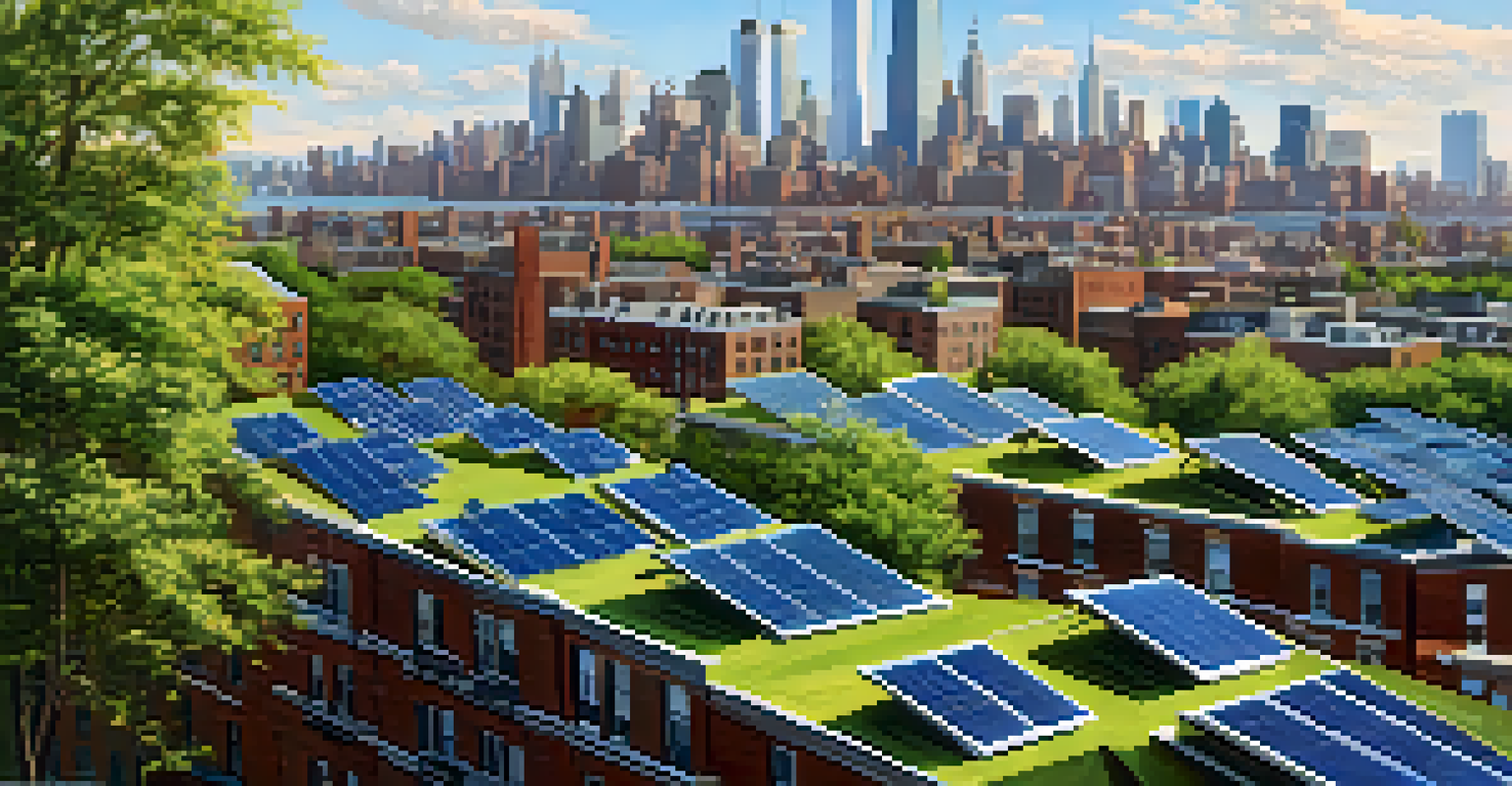The Role of Technology in Revamping NYC's Infrastructure

Smart Transportation: Redefining Urban Mobility
New York City's transportation system is undergoing a significant transformation, thanks to advances in technology. Smart traffic lights, for instance, are being implemented to improve the flow of vehicles and reduce congestion. These lights use real-time data to adapt their timing based on traffic patterns, making commutes smoother and more efficient.
Technology is best when it brings people together.
Moreover, the integration of mobile applications allows commuters to access real-time information about public transport schedules and delays. This means riders can plan their journeys better, reducing wait times at stations. In a bustling city like NYC, every minute counts, and technology is making a tangible difference.
Additionally, electric and autonomous vehicles are gradually becoming a part of the city's landscape. These innovations not only promise to reduce emissions but also enhance safety on the roads. As these technologies become more mainstream, they will redefine urban mobility in ways we are just beginning to understand.
Revamping Energy Systems for Sustainability
New York City is focusing on creating a more sustainable energy infrastructure to combat climate change. The introduction of smart grids plays a pivotal role, allowing for better management of electricity usage. These grids can monitor energy consumption in real-time, making it easier to identify inefficiencies and reduce waste.

Solar energy is also gaining traction, with numerous rooftops being equipped with solar panels. This shift not only decreases reliance on fossil fuels but also empowers residents to take control of their energy sources. By harnessing the sun’s power, NYC is paving the way for a cleaner, greener future.
Smart Tech Enhances Urban Mobility
New York City's transportation is transforming with smart traffic lights and mobile apps that optimize commutes and reduce wait times.
Furthermore, advancements in battery storage technology ensure that excess energy generated from renewable sources can be stored and used during peak demand times. This balance is crucial for maintaining a reliable energy supply while promoting sustainability throughout the city.
Smart Waste Management: A Cleaner City
Waste management in New York City is evolving with the help of technology, leading to a cleaner urban environment. Smart bins equipped with sensors notify waste collectors when they’re full, optimizing collection routes. This not only saves time and resources but also reduces unnecessary emissions from collection trucks.
The future belongs to those who believe in the beauty of their dreams.
Additionally, data analytics is being used to monitor waste generation patterns across neighborhoods. By understanding these patterns, the city can implement more effective recycling and composting programs tailored to specific areas, encouraging residents to participate.
Moreover, initiatives like the NYC Department of Sanitation's 'Zero Waste' goal demonstrate the city’s commitment to reducing landfill contributions. Technology will be key in tracking progress and ensuring that these ambitious targets are met, promoting a more sustainable future.
Enhancing Public Safety with Tech Innovations
Public safety is a top priority for New York City, and technology is a powerful ally in this effort. The deployment of smart surveillance cameras equipped with AI capabilities allows for real-time monitoring of streets and public spaces. These systems can identify suspicious activities, alerting law enforcement to potential threats before they escalate.
In addition, emergency response systems are being improved with the use of mobile applications that allow citizens to report incidents directly to authorities. This streamlines communication, ensuring that help can arrive more swiftly in critical situations.
Sustainable Energy Initiatives Grow
The city is adopting smart grids and solar energy to create a more sustainable energy infrastructure and reduce reliance on fossil fuels.
Moreover, community engagement platforms enable residents to connect with local police and share concerns, fostering trust and collaboration. By harnessing technology, NYC is not only enhancing public safety but also creating a more connected community.
Building Smart Infrastructure: From Roads to Bridges
Infrastructure development in New York City is becoming smarter and more resilient through technology. Engineers are now utilizing advanced materials and sensors in construction projects, allowing for real-time monitoring of structural integrity. This proactive approach helps identify issues before they become serious problems, prolonging the lifespan of infrastructure.
Smart roads equipped with embedded sensors can communicate with vehicles, providing essential data on road conditions and traffic patterns. This feedback loop enhances safety and efficiency, making travel more predictable for everyone.
Additionally, the use of 3D printing technology in construction is revolutionizing the way structures are built. This method allows for faster, more cost-effective projects while minimizing waste, creating a win-win scenario for both the city and its residents.
Data-Driven Decision Making: The Backbone of Innovation
At the heart of NYC's technological transformation is data-driven decision-making. The city is collecting vast amounts of data from various sources, including traffic patterns, energy usage, and public health metrics. By analyzing this data, city planners can make informed decisions that directly impact residents' quality of life.
For example, predictive analytics can forecast traffic congestion, allowing for adjustments in public transit schedules or road maintenance. This proactive approach helps mitigate issues before they escalate, improving overall urban mobility.
Data Drives NYC's Innovation Strategy
By leveraging data-driven decision-making, NYC is improving urban living through informed planning and community engagement.
Furthermore, citizen engagement platforms collect feedback from residents, ensuring that their voices are heard in the planning process. By integrating community input with data analysis, NYC is building a more responsive and inclusive city.
Challenges and Solutions in Tech Implementation
While the integration of technology in NYC's infrastructure presents numerous benefits, it also comes with its challenges. High costs and the complexity of implementing new systems can deter progress. Moreover, ensuring that all neighborhoods benefit equally from these advancements is crucial to avoid deepening existing disparities.
To address these challenges, public-private partnerships are playing an essential role. By collaborating with tech companies, the city can leverage expertise and resources while sharing the financial burden, making projects more feasible.

Additionally, ongoing community outreach and education efforts are vital to ensure that residents understand and can make the most of new technologies. By fostering a culture of innovation and inclusivity, NYC can navigate these challenges and build a brighter future.
Looking Ahead: The Future of NYC's Infrastructure
As New York City continues to embrace technology, the future of its infrastructure looks promising. Innovations in areas such as artificial intelligence, machine learning, and the Internet of Things will further enhance urban living. These technologies have the potential to create more efficient systems that adapt to the needs of residents in real time.
Moreover, as sustainability becomes a central focus, NYC is likely to invest more in green technologies that promote environmental health. From urban gardens to renewable energy sources, the city is poised to lead the way in sustainable urban development.
Ultimately, the role of technology in revamping NYC's infrastructure is not just about efficiency; it's about building a city that works for everyone. By prioritizing inclusivity and sustainability, NYC can set a benchmark for urban excellence in the years to come.